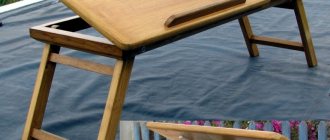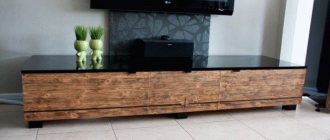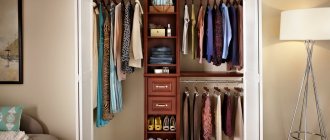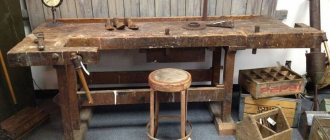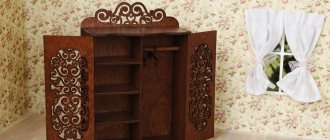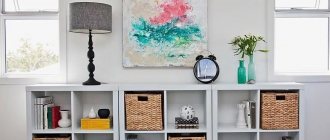During a burglary, time is the attacker’s most valuable resource. It can be significantly limited by connecting the apartment to a 24-hour security console and storing valuables in a burglar-proof safe. The arrival time of the armed squad is 5-20 minutes, and the task of the safe is to hold out against the burglar during this time. You can make the thief's task even more difficult if you force him to spend extra time searching for the safe. Let's figure out how to do this.
How to hide a built-in safe.
Most built-in safes are designed to be installed in a pre-prepared niche. This installation method is three times the most reliable: the most technologically complex and the most expensive. In addition, a significant limitation on wall thickness makes it unsuitable for panel apartment buildings. Read about the technology here: “Video instructions for installing a built-in safe.”
Thanks to detective stories and spy action films, we are well aware that such safes are hidden behind paintings or mirrors. But using these hackneyed solutions is not the best idea: firstly, thieves also watch movies, and secondly, it will be inconvenient for you to open such a safe. However, if you really want to try on the role of your favorite movie character, then why not.
The painting slides back along the guides, revealing access to a safe in the wall.
First, you need to decide on the room to install the safe - it should be impassable. A dressing room, bedroom, personal office, basement or attic are quite suitable. But the hallway and living room in this sense are not the best options. The bathroom is also not the best room - high humidity can lead to damage not only to the lock, but also to the contents of the safe itself.
Next, you need to think about how exactly to hide the safe. In the dressing room it can be curtained with clothes on hangers or placed with boxes on the shelves. In the bedroom, the safe can be covered by a wardrobe with a slot in the back wall or a bedside table.
Here are some interesting ideas, in my opinion, for installing a built-in safe:
The built-in safe is hidden behind clothes hung on hangers. Convenient and not conspicuous.
The dressing room through the eyes of a stranger, and how the owner sees it.
What size should I choose for a safe for an apartment?
In addition to installation method and design, home safes are also classified by size, and this also needs to be taken into account (it is not uncommon for people to buy safes that are much smaller than they need). Money, for example, should be stored in a small safe that is easy to hide and carry. But you can no longer hide large items and folders in a mini-safe. If the area of your apartment is limited, then give preference to a compact model that can be installed on the floor, attached to the wall and taken out (if you move).
Owners of country houses can easily afford to install a large safe, which has various shelves and cash drawers due to its large size. And this, in turn, allows you to rationally use the internal space of a large safe and place everything valuable there.
Burglar-resistant safe in the dressing room. When they hit the color
Mini safe
How to hide a floor safe.
Floor safes are the easiest to install and therefore the most common. When choosing a room for their installation, the same rule applies - the fewer strangers, the better.
Once you’ve decided on the room, you need to figure out how to hide the safe—hiding it with something like a built-in one won’t work. But you can still come up with something.
The first option is secretive - building a safe into a closet. This option has two points that you should pay attention to. First, the dimensions of the safe must be such that the cabinet closes normally. Keep in mind that safes with external hinges cannot be pushed flush with the hinge side against the side wall of the cabinet, since in this case it will not be possible to open it normally. The second point is that if the safe is heavy enough, you need to think through the design so that it does not push through the shelf or cabinet base.
An example of integrating a furniture safe into a closet. In the photo: Technomax GMT/4 (weight 34 kg)
When you have a non-working microwave, a compact furniture safe and creative thinking. Pictured is AIKO T-17 EL.
The second practical option is to install a safe under the table. The easiest way to install safes up to 70 cm high. Weight in this case does not matter, since the safe is placed directly on the floor and secured with anchors. As a result, the safe is covered on three sides by a table, which gives the owner convenient access without getting up from his desk. An excellent option for a personal account.
In the photo: LibertySafe PREMIUM HOME 05GYM fire-resistant safe.
The third option is aesthetic - styling the safe as an interior item. For example, under a decorative cabinet or dressing table. With this approach, the safe will fit into the interior design as organically as possible, and as a result will not stand out or be conspicuous.
Not everyone will guess that this decorative cabinet is actually a fire-resistant safe.
Today you can order the manufacture of a safe in a hidden design - the desired size, color of finish. This customization makes it easy to fit the safe into the interior. Pictured is SafeWood 78 EL DS2.
When thinking about how best to hide a safe, do not forget about the importance of its installation. Professional installation carried out correctly, in compliance with technology, significantly increases the resistance of the safe to burglary. Conversely, neglecting the fastening eliminates the burglar-resistant qualities of the safe when it is stolen along with its contents. For more information on this topic, read: “Installing safes - technology.”
Protection against burglary is solved in the following way: setting up an alarm system in the apartment, purchasing a burglar-proof safe and installing it correctly. This is the order and priority. How best to hide the safe is the fourth question. When answering it, it is better not to look for ready-made solutions, but to use your imagination. This is more likely to deprive attackers of valuable minutes and possibly save your valuables.
A safe is a special iron box designed for the safe storage of valuable items, documentation and things that must be stored in a protected form, in accordance with the law.
Safes vary in overall dimensions, wall material properties, lock design and fire resistance rating. Installed in government agencies, enterprises and private homes. Main purpose: protecting an item placed inside from unauthorized access by a circle of persons who do not have permission.
Advantages and disadvantages
The contents of the safe are protected due to the strength of the material from which it is made, as well as burglary-resistant locking devices. Reliability is also ensured by the factor of fastening the metal box to a fixed surface - the floor or wall.
Factory-produced safes are manufactured to standards that ensure maximum strength and burglary resistance. This explains their high market value. The price of such products is the main disadvantage of factory-made safes.
Homemade ones are made from scrap materials: corners, sheets of metal, hinges and locks, which significantly reduces the price.
Such caches are designed taking into account all the needs of the user and fit best into the corresponding interior.
A homemade safe, along with its advantages, has several disadvantages. Against the background of these advantages, a low threshold for the safety of storing items appears as a glaring disadvantage. The ordinary properties of metal and other components cannot provide sufficient structural strength . This factor underestimates the likelihood of content being saved.
Materials
List of materials needed to make a safe with your own hands.
Made of metal
- Sheet metal, the thickness of which is not less than 2 mm and complies with the parameters established by law, if applicable. Components that ensure the operation of the door: a lock and internal hinges, which are installed as hidden.
- Iron corners 30x30 mm. The size varies depending on the characteristics of the safe as a whole. The number of corners required for welding the frame is determined by the dimensions of the cache.
If items of safety fall into the list of items whose storage is described by law (for example, weapons, medicines), the safe is equipped with two locks of different types.
Made of wood
A wooden safe can be made from plywood of sufficient thickness. It is worth choosing the thickest sheets possible. Plywood is the best material for making a wooden safe because of its ply structure, which provides cross-strength to the wood fibers.
- Bars with dimensional parameters of at least 45x45 mm. They are used to assemble the internal frame and provide the ability to fasten plywood walls from the inside.
- Metal fasteners: corners, plates, hinges, screws. Locking devices.
A wooden safe has the lowest security and burglary resistance. It is used to preserve items of low value.
Fire resistant
This modification of the safe provides for the presence of two-layer walls, between which there is a fire-resistant protective layer. When making such a cache, you will need sheet asbestos (soft) or a heat-resistant cement-sand mixture.
Dimensions and drawings
The parameters of the safe are determined by the needs of its user. If there is no box with the specified dimensions on sale, you can make it according to your own drawings. When developing them, it is worth taking into account the regulations prescribed by law.
Safes used to store firearms and ammunition must be made of metal 2-3 mm thick. When storing cartridges, the minimum wall thickness is 3 mm. These parameters are reflected in the drawing.
Height, width and length are values determined by the dimensions of the object, which is the largest among those that will be inside. A limited supply is added to them to ensure the convenience of removing or placing the item in the safe.
A common safe used in everyday life is a small cache of compact dimensions. Fewer materials will be used for its production, which will reduce material costs.
It can easily be placed in a closet or other location suitable for installing a security box.
Step-by-step instruction
Drawing of a small safe for documents, money or tools (pictured 2):
- side wall;
- loop sockets;
- top part;
- back wall.
Step 1
Using a grinder and a cutting wheel, cut off blanks from the metal corner, the length of which should be equal to the overall dimensions of the future safe. Number of corner strips – 8 pcs.
Step 2
Weld the workpieces together as shown in photo 3. Clean the seams as much as possible to prevent scale from getting between the frame and the outer walls and disturbing the geometric shape of the safe.
To strengthen the structure, you can weld longitudinal and transverse strips parallel to the planes of the walls, which can be used as seats for the shelf. It will be attached to them using bolted connections, for which holes of the appropriate diameter must be drilled in the jumpers.
If this is not done in advance, drilling holes in the lintels of the assembled safe will be a very difficult process.
Step 3
Weld blanks for the walls, bottom and top to the frame. All parts must fit tightly to each other at the points of contact - at the corners. The presence of cracks is unacceptable.
The welding seam is applied in several stages. From the inside, along the line of contact between the metal wall sheets and the corners of the frame, point “tacks” are made. The distance between them is from 3 to 5 cm. This is necessary so that the iron does not deform under the influence of the temperature difference that occurs between the areas being welded and other, colder parts of the metal workpiece. Welding manipulations performed at all stages are carried out according to a similar pattern of preliminary point fixation. Welding points are also placed outside, along the line of all corners.
All internal connections of the frame to the walls are welded with a continuous seam, with periodic breaks for thermal stabilization (cooling of the metal area). External corners are welded according to the “heap” principle. This is necessary to prevent the occurrence of “sinks” during subsequent grinding of the joints. If “shells” are present, they must be boiled.
All available joints are processed. At this stage it is easiest to do.
Step 4
Arrangement of the front part. Along the contour of the front wall of the safe, on which the door will be located, a frame is welded, consisting of metal strips of the same thickness as the walls. Its width is 0.5-1 cm smaller than the width of the corner used to arrange the frame.
Due to the difference in size, a small groove-step is created along the contour of the entrance opening of the drawer, into which the door sits when closed. The connection of the frame to the main body is welded according to the principle described in step 3.
Step 5
A strip with holes is welded to the inside of the frame, which will serve as mounting holes for the extended lock bolts. The number of holes and their centers are determined by the structure of the locking device and its location on the plane of the door.
External or hidden hinges are welded on the opposite side of the frame. Their fastening is shown in photo 4. Secret hinge mechanisms are more reliable than regular ones - they cannot be cut off without opening the safe. Welding of the U-shaped part to the hinges and door is carried out after the latter has been modified and installed.
Step 6
To attach a regular lock or a lock with buttons to the door leaf, a fastening platform is installed. It is made from the same corner as the frame. This part is welded on the inside of the door. The lock placed on it with bolts must coincide with the holes in the side bar. A key hole is cut/drilled.
Step 7
The safe is coated with an anti-corrosion agent and then painted in several layers. Preference is given to “hammer” paint. It is a durable paint coating and creates a pleasant texture.
Gun safes
A separate category that deserves special attention. Such products are used to store firearms and ammunition. In most countries, including here, you must have such a gun safe at home to obtain a firearms license. The wall thickness must be at least 2 mm (for weapons) or 3 mm (for ammunition).
Decree of the Government of the Russian Federation N 814 “On measures to regulate the circulation of civilian and service weapons and ammunition for them on the territory of the Russian Federation.” File for download (click on the link to open the file in a new window).
Decree of the Government of the Russian Federation N 814
Master Class. Making a gun safe with your own hands
Let's look at how to make such a safe at home. What is typical is that it can be used not only for storing weapons, but also for other purposes. To make this design, prepare hinges (they can be purchased at the store), screws, and scrap lumber.
This gun safe is easy to make with your own hands.
After preparing everything you need, proceed directly to the manufacturing process.
Step 1. First, make a plan diagram, as in the photo below.
Weapons cabinet assembly diagram
Step 2. Make the base of the frame from a 5x10 cm board. Take a piece of board (about 150 cm long), cut it lengthwise into bars that have a cross-section of 3x5 cm. Also prepare 4 bars 5x10x50 cm and 4 - 5x10x35 cm. From them, assemble one, as in the photographs, construct the structure by installing a couple of lower bars 35 cm long “flat”. Lay the rest “on the edge”. Use screws to connect the bars.
Assembling a structure from bars
Build process
Install a pair of bottom bars “flat”
The bars are attached with screws
This is what should happen
Step 3. Make the back wall of the structure from plywood (can be made from several parts). The dimensions of the wall are 56x150 cm. Screw the finished wall using screws.
Screwing the back wall
Step 4. The side walls must be attached from the inside. Measure the frame from the inside. At the corners of the top/bottom of the plywood sheet, cut out 5x10 cm grooves in the locations of the frame boards.
The side walls are attached from the inside
Angle marking
You need to cut a groove according to this marking
Step 5. Lay the bottom on those bars that are placed “flat”. It's simple.
Bottom part
Step 6. Cut out the ceiling panel, screw it to the bars from the inside.
Top part
Step 7. Insert 5x10x35 cm bars on the sides between the vertical bars and screw them. Thanks to this, the structure will be strengthened.
Side inserts
Step 8. Make gun rests from a 5x10 cm board. Mark the recesses and cut them with a jigsaw. Screw the stops on three sides, as in the photo. If shelves will also be installed, install stops under them.
Notches are marked
Notches cut
Shotgun rests and shelf above them
Step 9. Assemble the door frame from a 5x10 cm board. Above the middle, make an additional insert; as a result, you will get a kind of square on top. When connecting parts, tighten the screws at an angle. Cut off any protruding caps with a grinding machine.
Door frame
Hats need to be cut off
Step 10. Bevel the inside of the resulting frame. Next, take the plywood panels you prepared for the door and round the corners. Screw the panels. Make a decorative frame on the outside of the door using a cutter.
Remove the chamfer from the inside of the resulting frame.
Corners need to be rounded
Docked panels
Use a cutter to create a decorative frame on the front side of the door on the frame.
Step 11. Mark the locations of the loops, make a cut according to the marks, the depth/length of which corresponds to the thickness/height of the loop. Install and secure the hinges using the same screws.
Gun safe prices
gun safe
Drank under the door hinge
Step 12. Sand the cabinet and caulk or fill the cracks to prevent moisture and insects from getting inside. Install the lock, paint the gun color of your choice. That's it, the design is ready for use! If you want, you can decorate it further.
Do-it-yourself ready-made gun cabinet
Interior arrangement of the cabinet
Incombustible
A fireproof safe differs from a regular safe in its structural characteristics, which prevent the combustion of stored items. Its walls consist of two layers, between which there is a protective material.
To make such a cache, you must follow steps 1 to 3 described above. At the next stage, weld another cubic metal box, the parameters of the sides of which will be at least 5 cm less than the parameters of the sides of the main body. As a result, you should get two boxes: one larger, and the second smaller, freely inserted into the first.
The space that is created between the outer and inner boxes is filled with fireproof material. It can be used as a concrete mixture or soft sheet asbestos laid in several layers. The inner box is fixed inside the outer box using connecting jumpers, which are welded after laying the fire-resistant material. The door is also made of two layers. A lock and fireproof material used to insulate the walls are placed inside it.
Advice from professionals
Experts advise choosing a safe that best suits the consumer’s needs. When creating generalized requests for safe characteristics, you need to pay attention to the following factors.
- Burglary resistance. Determine the reliability parameters of locks that can be installed in the cache and select the highest ones.
- Quantity and standards of locking elements. The more locking points of a non-standard device are introduced into the safe, the greater the likelihood of the safety of the contents.
- Combination of different types of locks. Keys with code or screw, electronic.
- Loop location. Hidden hinges are more reliable than external ones.
The degree of security of the contents of the safe is also determined by its location in the room and the reliability of its fastenings. It is advisable to place the cache in a wall niche or other place inaccessible to view. Regardless of the location, the safe must be securely attached to the wall or floor. For this purpose, metal anchor bolts are used, mounted from the inside, which limits access to them.
Taking into account the above factors, you can select or design a reliable safe yourself, which will ensure the safety of valuables and protect them in the event of a fire or other emergency.
To learn how to make a safe with your own hands, see the following video.
Almost every home contains valuable property that may be of interest to thieves. First of all, we are talking about cash, jewelry, some important documents, family heirlooms. A safe will help ensure their safety. If you are already determined to purchase a durable and reliable metal cabinet to hide your valuables, then it’s time to think about its design and installation location.
Today we will talk about which safe to choose for your home. This question is not idle. If you don’t pay enough attention to it, you may end up buying a safe that will not bring you peace of mind and confidence in the future, since it will not be able to become a serious obstacle to an attacker.
No. 5. Safe type
It is very important to decide in advance what you will store in the safe in order to choose the appropriate model. So, today the following basic options are popular:
, which is equipped with several shelves for convenient storage of papers;
safe for documents- safe for valuables , jewelry;
- gun safe . It will be useful for those who are fond of hunting and have bladed weapons and firearms at their disposal. There are different models designed to hold different numbers of different sized guns;
- a combination safe is an excellent option for an apartment, because it has sufficient functionality for storing various kinds of valuables;
- A safe for magnetic media is designed for storing flash drives, disks, and films. This is a small structure that will fit in any apartment and will protect all important materials from burglary and fire;
- A mini-safe is a great invention for the smallest apartments, whose owners need to securely store money and jewelry. These are very compact, lightweight, but at the same time, reliable designs that will ensure high safety for things.
Deciding on the type of safe design
What dangers may threaten the valuables stored in your home? Firstly, they could simply be kidnapped. Secondly, they may die in a fire, from which none of us, alas, are insured. (Of course, you can add floods, earthquakes, tornadoes, tsunamis, etc. to this list, but the likelihood of all these emergencies is incomparably lower.) Safes can protect your documents, money, jewelry from both. But... you will have to choose what to fear more, because most safes are not able to protect equally reliably from both fire and burglary. A fireproof safe will not stop a professional security guard, and a burglary-proof safe will not save you from fire.
Fireproof safes
According to statistics, in the vast majority of cases, the danger to valuables stored in the house comes from fire, and not from intruders who illegally entered your home. However, fire-resistant safes are purchased less often than burglar-resistant ones - as a rule, only in cases when it comes to storing some personal documents, photographs, family heirlooms that are very expensive for you, but are not of particular value to thieves .
A fireproof safe is designed to provide long-term protection of items stored in it from exposure to temperatures of several hundred degrees. This is achieved by filling the space between the internal and external walls of the safe with fire-resistant foam concrete, which has a fine-porous structure and, as a consequence, low thermal conductivity. To ensure fire-resistant properties, the doors use a so-called thermal lock and/or heat-insulating gaskets that expand when heated.
The average fireproof safe protects its contents from fire for 30-60 minutes. This, as a rule, is enough for called firefighters to extinguish the flame. Some more expensive models can resist heat for 120 and sometimes even 240 minutes. In general, all safes are divided into 6 classes according to their fire resistance. The criteria on the basis of which a metal box is classified into one class or another are the time of permissible thermal exposure and the maximum temperature inside the safe when the outside temperature rises to 1100 °C.
The maximum temperature inside the safe during a fire determines the type of storage objects. For example, safes that maintain temperatures up to 170 °C are designed for storing paper documents, and in so-called data safes, which guarantee that the temperature inside does not rise above 50 °C, you can store magnetic storage media (flash drives, CDs and DVDs, etc.).
Do not forget that fire-resistant safes only protect against flames and are not able to stop a burglar. They are not even attached to the wall or floor like burglar-resistant ones, since this can negatively affect the ability to withstand elevated temperatures. It follows from this that such safes should be hidden as far as possible from prying eyes.
Burglar-resistant safes
The main characteristic of burglar-resistant safes is their resistance to burglary, which is determined based on test results. Good burglary resistance can be guaranteed by heavy, high-strength concrete, which is used to fill the space between the outer and inner walls of the safe (sometimes the concrete is additionally reinforced with metal, granite chips or corundum). It is thanks to this “filling” that burglar-resistant safes turn out to be significantly heavier than fire-resistant ones.
In accordance with the empirically established resistance of safes to burglary, they are all divided into several classes:
1. Class H0 safes are relatively simple metal boxes with walls up to 5 mm thick; they are designed to protect against dishonest guests or employees rather than against burglars.
2. Class I-II safes are usually used for storing documents, relatively small amounts of money and weapons at home.
3. Safes of class III protection are purchased by those who intend to store large sums of money and especially expensive jewelry at home.
4. Safes that meet burglary resistance classes IV-VII are classified as professional; they are designed to ensure the safety of money, jewelry and documentation in banking premises, but are practically not used by private individuals.
Of course, if we are talking about a burglar-resistant safe, we should not forget about the need to equip it with a high-quality lock, otherwise super-strong walls and doors will be worthless. Let us also note that the best option for ensuring the safety of your valuables involves an integrated approach: it is not enough just to equip a reliable storage facility; you also need to connect the house to a remote control system.
10-15 minutes after the sensors are triggered, a police squad will arrive at the scene, which reduces the chances of criminals to make money to zero. If an intruder who has entered your home has enough time, with the appropriate skills, he will sooner or later be able to cope with any, even the most reliable safe.
Fire-resistant safes
A little higher, we stated that all safes have their own narrow specialization. But, as you know, there are exceptions to every rule. In this case, the exception is the category of universal safes that can perform both functions. Fire-resistant models, which will help preserve property during both robbery and fire, are rare and are quite expensive. In addition, they, as a rule, provide the minimum permissible level of protection, corresponding to the lowest classes in both fire and burglary resistance.
Types of locks used in safes
The burglary resistance of a safe is determined primarily not by the thickness of its “armor,” but by the reliability of the lock installed on it. Today, safes are equipped with three types of locks: key, combination (which, in turn, can be mechanical or electronic) and biometric.
Key lock
One should not think that in our digital age, key locks are preparing to retire. No, they are still used more often than any other. Cylindrical locks are installed on safes extremely rarely - preference is given to lever locks, which are more resistant to the use of master keys and forceful breaking. To increase the reliability of safes, they are sometimes equipped with two locks, the keys of which are strongly recommended to be hidden in different places.
An additional element of protection can be an electronic chip placed on the key itself. The locking device will be blocked if it does not recognize the chip. Such a system allows you to protect against the use of duplicate keys made from an impression.
Mechanical combination lock
Combination mechanical locks, often called dial locks, are strongly associated in the minds of most of us with safes. Such a lock requires the introduction of a code combination of numbers, for which there is a rotating knob on the outside of the door with a scale from 0 to 99. Trying to guess the code by simply searching is pointless - given the number of possible combinations, it will take months, or even years. The security of a combination lock depends largely on the owner's ability to keep the code secret.
Electronic combination lock
Electronic combination locks have a number of significant advantages over mechanical ones. Electronics are more flexible in operation. Such a lock can be programmed to the mode that best suits your security requirements. If desired or necessary, you can easily change the code (in the case of many mechanical combination locks, this operation is impossible in principle). In addition, the electronic mechanism has a combination protection function. However, it should be borne in mind that electronics are more likely to fail than mechanics; in the case of safes, this can be fraught with trouble.
Biometric lock
The biometric device identifies the owner of the safe using some unique individual parameters. This could be, for example, fingerprints or the appearance of the retina. Such safe locks are much more expensive than classic ones. Before choosing a safe with a biometric lock for your home, consider whether the cost of the vault will exceed the value of its contents. It hardly makes sense to chase this trend of safe fashion, because traditional locks cope with the task no worse.
In conclusion, we will give you some tips regarding choosing a lock system for your home safe:
When choosing a particular type of locking system, you should focus on the frequency of use of the safe. If you expect to open and close your vault quite often, we advise you to give preference to a key lock: it is more convenient and will last longer. If you will not use the safe very actively, you should choose a combination lock.
The best possible option is a safe equipped with two different types of locks, for example, a key and a code.
We recommend choosing less common safe models, since many burglars have master keys for specific types of popular locks installed on mass-produced products.
What to look for when choosing a safe?
To choose the right model, consider several factors. Since it must meet all safety standards, we advise you to pay attention to such characteristics.
- Lock type. A key lock, which has a high security class, is more suitable for storing expensive items. For convenient partial access to values, give preference to the code model. And if you will use the safe only occasionally, then buy a model with a mechanical combination lock.
- Safe type . It is selected taking into account the personal preferences of the buyer. Nowadays, not only specialized products for jewelry are sold, but also combined safes equipped with numerous shelves and cells.
- Dimensions, installation method. If the apartment is large, then you can buy a large safe and store money, jewelry, and securities in it at the same time. Such safes are usually installed in offices. But in the bedroom it is better to install a mini-safe.
The dimensions of the safe may vary.
You should also check whether all the necessary certificates are available and whether warranty service is provided. It is important to buy a model with reliable thick walls. For example, the fire-burglary-resistant models mentioned above have walls that resemble a sandwich in cross-section.
Note! All hinges should be located inside, with the exception of very heavy models - these are produced with external hinges, and the door is locked at each edge. The body must not have visible joints or seams.
External hinges are allowed in heavy safes
Door on internal hinges
About burglary resistance classes
In this aspect, there are 12 classes, and this is what attention is paid to first when choosing a specific model. The higher the class, the more difficult it is to open the safe door. Often, products are marked “O” or “BUT”, indicating that the safe cannot resist burglary and should be used only for fire protection. Such models are made of special steel (its thickness can reach 3 mm), often laid in several sheets, and the voids between them, as noted earlier, are filled with concrete. To increase burglary resistance, several types of locks are used.
The burglary resistance of safes varies
It is recommended to store money and documents in a safe with resistance class 3-4, and jewelry - at least class 5.
Note! If something particularly valuable is stored in the safe, it should be at least a class 6 model.
About fire resistance
When choosing a “cache”, pay attention to its fire safety characteristics. To store especially valuable items, you can buy a special fire-resistant model, which, in addition to all of the above, may also have a heat-insulating seal with a lock.
Safe with biometric lock
Pay attention to whether the safe has all the necessary certificates and testing documents. Valuable documents and money should be stored in a product with additional protection (these belong to category B). Less valuable documents and magnetic media can be stored in a DIS category safe.
What to look for when choosing a safe for an apartment
Choosing a safe placement method
There is no safe that cannot be opened. The success of the enterprise depends on the quality of the storage facility itself, the skill level of the burglar and the time he will have to work. By reliably hiding the safe from prying eyes, you will thereby increase the time required to commit the theft, which means that the likelihood will increase that the thief will abandon his venture or will be caught in the act by a police squad arriving on cue. According to the method of placement, all safes are divided into several types.
Built-in safes
In terms of the time required to search for them, built-in safes are the most ideal. They are easy to disguise with furniture, interior elements, and decorative panels used in the decoration of the room. In addition, the wall, due to its mass, significantly increases the burglary and fire resistance of the storage facility.
However, such a safe can only be installed in a house with walls made of brick or aerated concrete blocks. However, you can install a metal box not only in the wall, but also in the floor, but only if the room is located on the ground floor of the building. In both cases, it is necessary to create a niche (or at least very desirable) at the construction stage.
Freestanding safes
Free-standing safes are classic home storage for documents, money, jewelry and other valuables. The vast majority of home safes fall into this category. Such boxes are purchased in cases where for some reason it is impossible to build a safe into the wall.
To increase the reliability of the storage facility, it should be attached to the wall, having previously mounted a powerful metal frame, or to a reinforced concrete platform on the floor. Just as with built-in safes, you need to do everything possible to ensure that a free-standing structure does not catch your eye when entering the room.
Furniture safes
Furniture safes are relatively lightweight structures placed inside cabinets or cabinets. It’s hard to call them reliable storage facilities. Firstly, it is basically impossible to install a thick-walled, and therefore quite heavy, safe inside furniture, which means that they all have a low burglary resistance class. Secondly, such a hiding place will be discovered instantly by an attacker, since thieves in most cases begin their search for valuables from cabinets, cabinets and chests of drawers.
Portable safes
Portable safes are essentially diplomats with reinforced metal walls and locks. They are used to transport documents and relatively small amounts of money. Of course, safes with such a low weight cannot have good protective properties - it will not be difficult for a criminal to steal such a cash box entirely. To increase reliability, such products are often equipped with additional radio beacons. One of the types of portable safes is a car box.
Which installation method should you prefer?
Despite the considerable number of types of home safes, the most popular are still furniture models, since they can be hidden in built-in cabinets. They are usually attached to the walls using anchor bolts, which are included in the kit. To provide additional security and strength, you can install the safe directly into the wall (usually, if the cabinet is located next to it, this is done). As for fireproof safes, they cannot be installed on the wall or floor; burglary-resistant models need to be secured to the floor (if there is a special stand for this).
Safe prices
safe
Furniture safe built into the closet
Note! If it is not possible to build in a safe, it is installed separately, but in this case you need to decide on the mounting in advance. As a rule, such products are attached to the floor with anchor bolts.
Safe in the dressing room
To make the safe fit into the overall interior of the room, place it in a row with a small cabinet and chest of drawers.
If the apartment is small and every square meter of space is worth its weight in gold, then it is better to give preference to a built-in safe, because it will take up a minimum of space and will be hidden from prying eyes. It will also not be easy for intruders to tear such a product out of the wall, which means additional protection is provided. Decorative elements are usually used to disguise built-in safes.
We also note that such models are demanding on the thickness of the wall - it must be at least 10 cm greater than the depth of the “cache”. For example, if the depth of the safe is 20 cm, then the wall thickness should be at least 30 cm. The installation itself is a rather labor-intensive, noisy and dusty process.
If we look at protecting against theft of valuables, then the best option for a home safe would be built-in models
On a note! It is recommended to install a built-in safe during renovation, even before finishing the walls.
Safe dimensions and internal divisions
The sizes of safes can vary over a fairly wide range, but for home use a compact model will be sufficient. In order not to make a mistake with the dimensions of the purchased product, you should decide in advance on the quantity and type of property to be saved. So, for example, if only money is supposed to be stored in the safe, then its internal dimensions can be only slightly more than a couple of packs of banknotes, while the storage for documents must obviously accommodate A4 paper.
But even if the size of the valuables to be stored is more than modest, you should not buy an overly small safe, otherwise it will be inconvenient to use.
Experts recommend purchasing several smaller safes instead of one large safe. An attacker, having discovered one of the safes, is unlikely to continue searching. But even if he manages to figure out the location of all the vaults, opening several locks is a time-consuming task, and this is not in the interests of the thief.
In most cases, safes are equipped with shelves, compartments and cells for convenient placement of things stored there. The organization of the internal space of the safe depends primarily on its internal dimensions. Owners of the smallest models have to be content with one compartment.
No. 1. Burglar resistance class
Safes are divided into 12 classes : the higher the class, the more difficult it will be to open the safe. In addition, some models are marked “0” or “H0”, which means that such a safe is practically not resistant to burglary, but can be used, for example, to save valuables from the destructive effects of fire.
In the manufacture of safes with a high level of burglary protection, strong steel sheets about 3 mm thick are used; the design may include several such sheets, the space between which is filled with concrete. The strength of the safe is also affected by the type of lock used : combination, electronic, lever, key. For maximum security, your safe should use at least two different types of locks .
As for the required burglary resistance class, a Class 3 safe is quite sufficient for home use . If you need to store important documents and considerable amounts of money, then it is better to pay attention to class 4, and for storing jewelry you need to choose a class 5 safe, which is designed just for this. If the contents of the safe are very expensive, then burglary resistance class 6 will be optimal.


